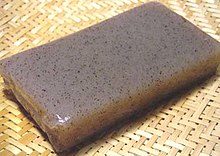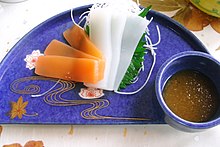Konjac
| Konjac Amorphophallus konjac | |
|---|---|
| Scientific classification | |
| Kingdom: | |
| (unranked): | |
| (unranked): | |
| Order: | |
| Family: | |
| Subfamily: | |
| Tribe: | |
| Genus: | |
| Species: | A. konjac
|
| Binomial name | |
| Amorphophallus konjac | |
Konjac (English: /ˈkoʊnjæk/ KOHN-yak; Amorphophallus konjac; syn. A. rivieri; Japanese: 蒟蒻/菎蒻; こんにゃく; konnyaku; Korean: 곤약; gonyak; Chinese: 蒟蒻; pinyin: jǔ ruò), also known as konjak, konjaku, konnyaku potato,[1] devil's tongue, voodoo lily, snake palm, or elephant yam (though this name is also used for A. paeoniifolius), is a plant of the genus Amorphophallus. It is native to warm subtropical to tropical eastern Asia, from Japan and China south to Indonesia.
It is a perennial plant, growing from a large corm up to 25 cm in diameter. The single leaf is up to 1.3 m across, bipinnate, and divided into numerous leaflets. The flowers are produced on a spathe enclosed by a dark purple spadix up to 55 cm long.
The corm of the konjac is often colloquially referred to as a yam, although it bears no marked relation to tubers of the family Dioscoreaceae.
Cultivation and use


Konjac is grown in India, China, Japan and Korea for its large starchy corms, used to create a flour and jelly of the same name. It is also used as a vegan substitute for gelatin.
In Japanese cuisine, konjac (konyaku) appears in dishes such as oden. It is typically mottled grey and firmer in consistency than most gelatins. It has very little taste; the common variety tastes vaguely like salt. It is valued more for its texture than flavor.
Ito konyaku (糸蒟蒻) is a type of Japanese food consisting of konjac cut into noodle-like strips. It is usually sold in plastic bags with accompanying water. It is often used in sukiyaki and oden. The name literally means "thread-konjac".
Japanese konyaku is made by mixing konjac flour with water and limewater.[2] Hijiki is often added for the characteristic dark color and flavor. Without additives for color, konyaku is pale white. It is then boiled and cooled to solidify. Konyaku made in noodle form is called shirataki and used in foods such as sukiyaki and gyudon.
Konjac is consumed in parts of China's Sichuan province; the corm is called moyu (魔芋 or devil's taro), and the jelly is called "konjac tofu" (魔芋豆腐 moyu doufu) or "snow konjac" (雪魔芋 xue moyu).
The dried corm of the konjac plant contains around 40% glucomannan gum. This polysaccharide makes konjac jelly highly viscous.
Konjac has almost no calories, but is very high in fiber. Thus, it is often used as a diet food. It can also be used for facial massage accessories which are currently popular in Korea.
The product Lipozene[3] is made from the konjac root.
Fruit jelly
Konjac can also be made into a popular Asian fruit jelly snack, known variously in the United States as lychee cups (after a typical flavor and Nata de coco cube suspended in the gel) or konjac candy, usually served in bite-sized plastic cups.
Choking risk
Perhaps because of several highly publicized deaths and near-deaths in the San Francisco Bay Area among children and elderly caused by suffocation while eating konjac candy, the U.S. Food and Drug Administration (FDA) issued product warnings[4] in 2001 and subsequent recalls in the United States and Canada. Unlike gelatine and some other commonly used gelling agents, konjac fruit jelly does not melt readily in the mouth. Some products formed a gel strong enough such that only chewing, not tongue pressure or breathing pressure, could disintegrate the gel. Although the product is intended to be eaten by gently squeezing the gel's cup, a consumer could suck the product out with enough force to unintentionally lodge it in his or her trachea. Konjac fruit jelly was subsequently also banned in the European Union.[5][6][7]
Some konjac jelly snacks are not of a size and consistency to pose any unusual choking risk, but are nonetheless affected by the government bans. Some products that remain in Asian markets have an increased size, unusual shape, and more delicate consistency than the round, plug-like gels that were associated with the choking incidents. The snacks usually have warning labels advising parents to make sure their children chew the jelly thoroughly before swallowing. Japan's largest manufacturer of konjac snacks, MannanLife, temporarily stopped production of the jellies after a 21-month-old Japanese boy was revealed to have choked to death on a frozen MannanLife konjac jelly.[8] 17 people have died from choking on konjac between 1995 and 2008.[9] MannanLife konjac jelly's packaging bag now shows a note to consumers, advising them to cut the product into smaller pieces before serving it to small children.
See also
References
- ^ About.com
- ^ "How to make konjac foods (shirataki noodles or konyaku) myself".
- ^ "Lipozene Ingredients". Retrieved 11 August 2011.
- ^ FDA issues a second warning and an import alert about konjac mini-cup gel candies that pose choking risk, FDA News P01-17, 5 October 2001
- ^ Directive of the European Parliament and of the Council amending Directive 95/2/EC as regards the conditions of use for a food additive E 425 konjac
- ^ Draft Commission Decision (SANCO/362/2002) suspending the placing on the market and import of jelly confectionery containing food additive E 425 Konjac, UK Food Standards Agency, 8 March 2002
- ^ Mini fruit gel sweets containing konjac, UK Food Standards Agency, 8 July 2003
- ^ Yomiuri, [1] [2]
- ^ Article from the Japan Times, "Food maker pulls 'konyaku' sweets", October 9, 2008
